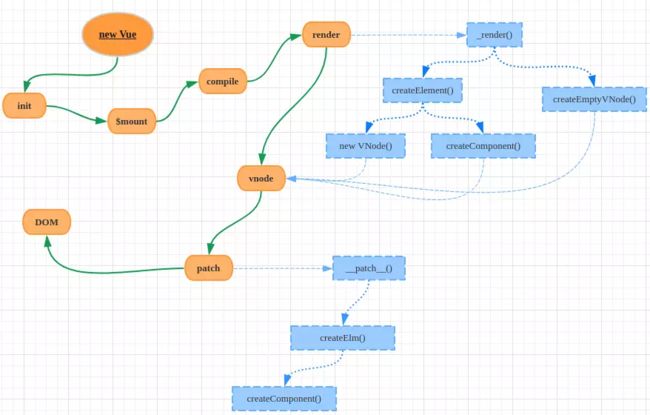Vue 全站缓存之 keep-alive
参考:
https://zhuanlan.zhihu.com/p/40628211
https://www.jianshu.com/p/9523bb439950
什么是页面缓存
用户的浏览行为应该是逐渐深入的,通俗得讲就是浏览页面在不断前进。
而且这些页面之间还是有互动性存在的,两种互动行为:
- 一. 用户前进时,总是进入新的页面。(比如在合同列表页反复加载多次列表之后,进入其中一个合同详情,再返回时,应该仍停留之前里列表页同一个位置,而不是重新刷新列表页。)
- 二. 用户后退时,需要能保留前一页数据并继续操作。(比如,记到账时需要选择合同,选择合同时可以新建合同,新建合同时填了一堆数据可以去选择客户,在选择客户时又去创建了客户,那么这一堆操作下来应该能够做到:
创建完客户后继续新建合同,建完合同后继续记该合同的到账)
keep-alive 是一种页面缓存组件
keep-alive是一个抽象组件:它自身不会渲染一个DOM元素,也不会出现在父组件链中;使用keep-alive包裹动态组件时,会缓存不活动的组件实例,而不是销毁它们。
vue 支持 keep-alive 组件,如果启用,页面内的所有数据都会被保留,所以,上文的互动行为二后退时保留前一页数据继续操作没有问题。
---------------------------------------------------------------------------------------------------------------------------------------
使用
vue页面要起名字
方式1:缓存所有页面
在vue.app页面中修改 使用keep-alive 组件
方式2:根据条件缓存页面
-
在 App.vue 里面
// 1. 将缓存 name 为 test 的组件
// 2. 将缓存 name 为 a 或者 b 的组件,结合动态组件使用
// 3. 使用正则表达式 过滤需要缓存的界面name
// 5.动态判断 写一个computed函数方法 过滤要缓存的界面name
// 5. 将不缓存 name 为 test 的组件
方式3:结合Router,缓存部分页面 不通过界面名字
- 在 router 目录下的 index.js 文件里
import Vue from 'vue' import Router from 'vue-router' const Home = resolve => require(['@/components/home/home'], resolve) const Goods = resolve => require(['@/components/home/goods'], resolve) const Ratings = resolve => require(['@/components/home/ratings'], resolve) const Seller = resolve => require(['@/components/home/seller'], resolve) Vue.use(Router) export default new Router({ mode: 'history', routes: [ { path: '/', name: 'home', component: Home, redirect: 'goods', children: [ { path: 'goods', name: 'goods', component: Goods, meta: { keepAlive: false // 不需要缓存 } }, { path: 'ratings', name: 'ratings', component: Ratings, meta: { keepAlive: true // 需要缓存 } }, { path: 'seller', name: 'seller', component: Seller, meta: { keepAlive: true // 需要缓存 } } ] } ] }) - 在 App.vue 里面
最后,我们说说原理
keep-alive.js的源码
export default {
name: 'keep-alive',
abstract: true, // 判断当前组件虚拟dom是否渲染成真实dom的关键
props: {
include: patternTypes, // 缓存白名单
exclude: patternTypes, // 缓存黑名单
max: [String, Number] // 缓存的组件
},
created() {
this.cache = Object.create(null) // 缓存虚拟dom
this.keys = [] // 缓存的虚拟dom的键集合
},
destroyed() {
for (const key in this.cache) {
// 删除所有的缓存
pruneCacheEntry(this.cache, key, this.keys)
}
},
mounted() {
// 实时监听黑白名单的变动
this.$watch('include', val => {
pruneCache(this, name => matched(val, name))
})
this.$watch('exclude', val => {
pruneCache(this, name => !matches(val, name))
})
},
render() {
// 先省略...
}
}可以看出,与我们定义组件的过程一样,先是设置组件名为keep-alive,其次定义了一个abstract属性,值为true。这个属性在vue的官方教程并未提及,却至关重要,后面的渲染过程会用到。props属性定义了keep-alive组件支持的全部参数。
keep-alive在它生命周期内定义了三个钩子函数:
- created
初始化两个对象分别缓存VNode(虚拟DOM)和VNode对应的键集合 - destroyed
删除this.cache中缓存的VNode实例。我们留意到,这不是简单地将this.cache置为null,而是遍历调用pruneCacheEntry函数删除。
// src/core/components/keep-alive.js
function pruneCacheEntry (
cache: VNodeCache,
key: string,
keys: Array,
current?: VNode
) {
const cached = cache[key]
if (cached && (!current || cached.tag !== current.tag)) {
cached.componentInstance.$destroyed() // 执行组件的destroy钩子函数
}
cache[key] = null
remove(keys, key)
}
删除缓存的VNode还要对应组件实例的destory钩子函数
- mounted
在mounted这个钩子中对include和exclude参数进行监听,然后实时地更新(删除)this.cache对象数据。pruneCache函数的核心也是去调用pruneCacheEntry
function pruneCache (keepAliveInstance: any, filter: Function) {
const { cache, keys, _vnode } = keepAliveInstance
for (const key in cache) {
const cachedNode: ?VNode = cache[key]
if (cachedNode) {
const name: ?string = getComponentName(cachedNode.componentOptions)
if (name && !filter(name)) {
pruneCacheEntry(cache, key, keys, _vnode)
}
}
}
}render
render () {
const slot = this.$slots.defalut
const vnode: VNode = getFirstComponentChild(slot) // 找到第一个子组件对象
const componentOptions : ?VNodeComponentOptions = vnode && vnode.componentOptions
if (componentOptions) { // 存在组件参数
// check pattern
const name: ?string = getComponentName(componentOptions) // 组件名
const { include, exclude } = this
if (// 条件匹配
// not included
(include && (!name || !matches(include, name)))||
// excluded
(exclude && name && matches(exclude, name))
) {
return vnode
}
const { cache, keys } = this
// 定义组件的缓存key
const key: ?string = vnode.key === null ? componentOptions.Ctor.cid + (componentOptions.tag ? `::${componentOptions.tag}` : '') : vnode.key
if (cache[key]) { // 已经缓存过该组件
vnode.componentInstance = cache[key].componentInstance
remove(keys, key)
keys.push(key) // 调整key排序
} else {
cache[key] = vnode //缓存组件对象
keys.push(key)
if (this.max && keys.length > parseInt(this.max)) {
//超过缓存数限制,将第一个删除
pruneCacheEntry(cahce, keys[0], keys, this._vnode)
}
}
vnode.data.keepAlive = true //渲染和执行被包裹组件的钩子函数需要用到
}
return vnode || (slot && slot[0])
}- 第一步:获取keep-alive包裹着的第一个子组件对象及其组件名;
- 第二步:根据设定的黑白名单(如果有)进行条件匹配,决定是否缓存。不匹配,直接返回组件实例(VNode),否则执行第三步;
- 第三步:根据组件ID和tag生成缓存Key,并在缓存对象中查找是否已缓存过该组件实例。如果存在,直接取出缓存值并更新该key在this.keys中的位置(更新key的位置是实现LRU置换策略的关键),否则执行第四步;
- 第四步:在this.cache对象中存储该组件实例并保存key值,之后检查缓存的实例数量是否超过max设置值,超过则根据LRU置换策略删除最近最久未使用的实例(即是下标为0的那个key);
- 第五步:最后并且很重要,将该组件实例的keepAlive属性值设置为true。Vue的渲染过程
Vue的渲染过程
Vue的渲染是从图中render阶段开始的,但keep-alive的渲染是在patch阶段,这是构建组件树(虚拟DOM树),并将VNode转换成真正DOM节点的过程。
简单描述从render到patch的过程
我们从最简单的new Vue开始:
import App from './App.vue'
new Vue({
render: h => h(App)
}).$mount('#app')- Vue在渲染的时候先调用原型上的_render函数将组件对象转化成一个VNode实例;而_render是通过调用createElement和createEmptyVNode两个函数进行转化;
- createElement的转化过程会根据不同的情形选择new VNode或者调用createComponent函数做VNode实例化;
- 完成VNode实例化后,这时候Vue调用原型上的_update函数把VNode渲染成真实DOM,这个过程又是通过调用patch函数完成的(这就是patch阶段了)
用一张图表达:
keep-alive包裹的组件是如何使用缓存的?
在patch阶段,会执行createComponent函数:
// src/core/vdom/patch.js
function createComponent (vnode, insertedVnodeQueue, parentElm, refElm) {
let i = vnode.data
if (isDef(i)) {
const isReactivated = isDef(vnode.componentInstance) && i.keepAlive
if (isDef(i = i.hook) && isDef(i = i.init)) {
i(vnode, false)
}
if (isDef(vnode.componentInstance)) {
initComponent(vnode, insertedVnodeQueue)
insert(parentElem, vnode.elem, refElem) // 将缓存的DOM(vnode.elem) 插入父元素中
if (isTrue(isReactivated)) {
reactivateComponent(vnode, insertedVnodeQueue, parentEle, refElm)
}
return true
}
}
}- 在首次加载被包裹组建时,由keep-alive.js中的render函数可知,vnode.componentInstance的值是undfined,keepAlive的值是true,因为keep-alive组件作为父组件,它的render函数会先于被包裹组件执行;那么只执行到i(vnode,false),后面的逻辑不执行;
- 再次访问被包裹组件时,vnode.componentInstance的值就是已经缓存的组件实例,那么会执行insert(parentElm, vnode.elm, refElm)逻辑,这样就直接把上一次的DOM插入到父元素中。
五、不可忽视:钩子函数
5.1 只执行一次的钩子
一般的组件,每一次加载都会有完整的生命周期,即生命周期里面对于的钩子函数都会被触发,为什么被keep-alive包裹的组件却不是呢?
被缓存的组件实例会为其设置keepAlive= true,而在初始化组件钩子函数中:
(可参考我写的vue生命周期)
// src/core/vdom/create-component.js
const componentVNodeHooks = {
init (vnode: VNodeWithData, hydrating: boolean): ?boolean{
if (
vnode.componentInstance &&
!vnode.componentInstance._isDestroyed &&
vnode.data.keepAlive
) {
// keep-alive components, treat as a patch
const mountedNode:any = vnode
componentVNodeHooks.prepatch(mountedNode, mountedNode)
} else {
const child = vnode.componentInstance = createComponentInstanceForVnode (vnode, activeInstance)
}
}
}可以看出,当vnode.componentInstance和keepAlive同时为true时,不再进入$mount过程,那mounted之前的所有钩子函数(beforeCreate、created、mounted)都不再执行。
5.2 可重复的activated
在patch的阶段,最后会执行invokeInsertHook函数,而这个函数就是去调用组件实例(VNode)自身的insert钩子:
// src/core/vdom/patch.js
function invokeInsertHook (vnode, queue, initial) {
if (isTrue(initial) && isDef(vnode.parent)) {
vnode.parent.data,pendingInsert = queue
} else {
for(let i =0; iconst componentVNodeHooks = {
// init()
insert (vnode: MountedComponentVNode) {
const { context, componentInstance } = vnode
if (!componentInstance._isMounted) {
componentInstance._isMounted = true
callHook(componentInstance, 'mounted')
}
if (vnode.data.keepAlive) {
if (context._isMounted) {
queueActivatedComponent(componentInstance)
} else {
activateChildComponent(componentInstance, true/* direct */)
}
}
// ...
}
}


